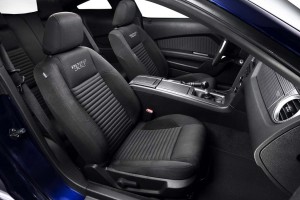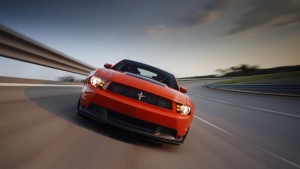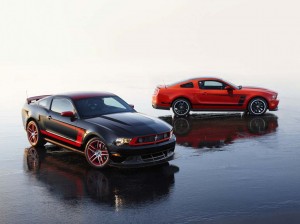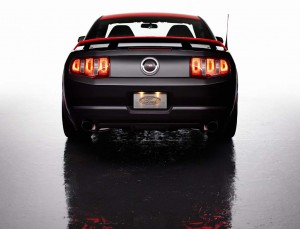The Boss is back…almost.
Ford lifted the covers on an all-new version of the Mustang Boss 302 during a preview at tony Pebble Beach, this morning, and promises to not only bring it to market for 2012, but to deliver, “the quickest, best-handling straight-production Mustang ever offered by Ford.”
As one would expect, the 2012 Boss 302 starts out with the solid underpinnings of the updated 2011 Ford Mustang. But the maker has made moves to optimize the pony car in a variety of ways, among other things increasing horsepower, while reducing weight and aerodynamic drag.
Meanwhile, the maker plans to offer a track-ready version, dubbed the Boss 302 Laguna Seca – for the challenging track on the Monterey Peninsula – which will delete the back seat for even more weight savings and get a new, race-ready suspension.
The 2012 Ford Mustang Boss 302 will hit the streets more than four decades after the original Boss debuted. The new model, company officials suggest, is a “race car with a license plate.”
“The entire team at Ford felt…the world-class 2011 Mustang could support a successful, race-bred, worthy successor to the original Boss 302,” contends Derrick Kuzak, group vice president, Global Product Development. “For us that meant a production Mustang that could top one of the world’s best – the 2010 BMW M3 – in lap times at Laguna Seca. We met our expectations.”
The current Mustang GT motor, which makes 412 horsepower, went through some aggressive modifications, starting with an all-new intake, a runners-in-the-box plenum velocity stack. Add revised camshafts, among other things and the Boss 302’s V8 will pump out 440 hp and 380 lb-ft of torque. That’s channeled through a modified clutch into a short-throw, close-ratio six-speed manual gearbox.

A look inside the 2012 Ford Mustang Boss 302 showing the Alcantra-covered steering wheel and IP treatment.
The rear axle ration of the Boss is 3.73, and a Torsen torque-sensing limited slip differential will be on the option list.
The Boss 302 Laguna Seca honors the track where Ford’s Parnelli Jones drove a Boss to victory in the 1970 Trans-Am season opener. The track-ready version will trade off creature comforts, Ford officials acknowledge, but gain body stiffness, a firmer chassis set-up and aerodynamic enhancements borrowed from the new Boss 302R race car.
The 2012 Ford Mustang Boss 302 also will feature a new, freer-flowing quad exhaust system that helps improve both power and the sort of resonant exhaust note a car like this is expected to deliver. The layout of the system is unusual, with two outlets exiting in the rear similar to a conventional Mustang GT. The other two exit to either side of the exhaust crossover, sending exhaust through a set of metal discs that act as tuning elements before the pipes terminate just ahead of the rear wheel opening.
“We added the attenuation discs to meet legal regulations, but we knew buyers might operate these cars in situations where noise regulations weren’t an issue,” Mustang NVH Engineer Shawn Carney said, adding that, “The disc is removable.”
The 2010 Ford Mustang Boss 302 is lowered millimeters, up front, a millimeter in the rear, compared to the stock Mustang GT. No, Ford still isn’t delivering an independent rear, but the stiffened suspension, which includes higher-rate coil springs, now gets adjustable shocks and struts, a driver able to choose from five soft-to-stiff settings.
What’s unusual is the decision to go with hands-on shock adjustability, which requires the driver to use a flat-head screwdriver to turn an adjustment screw at the top of the shock tower. Ford engineers say they ditched more high-tech electronic controls to hold down the overall vehicle weight.
But a driver can access a menu on the instrument cluster to electronically select one of three settings for the speed-sensitive steering system. Traction and Stability Control systems also can be set to street or track modes.
The 2012 Boss 302 will ride light 19-inch alloy wheels shod in Pirelli PZero summer tires. They will conceal – just barely – 14-inch, 4-piston Brembo front brakes. In the rear, the pony car gets an upgraded version of the Mustang GT brakes.
Top speed, according to Ford, is 155 mph. The 2012 Ford Mustang Boss 302 will be the maker’s first non-SVT pony car to achieve more than 1.0 g of lateral acceleration.
Each Boss 3022 will have a black or white roof panel, coordinated with the color of the side stripe.
The maker won’t talk price until closer to its launch for the 2012 model-year.



